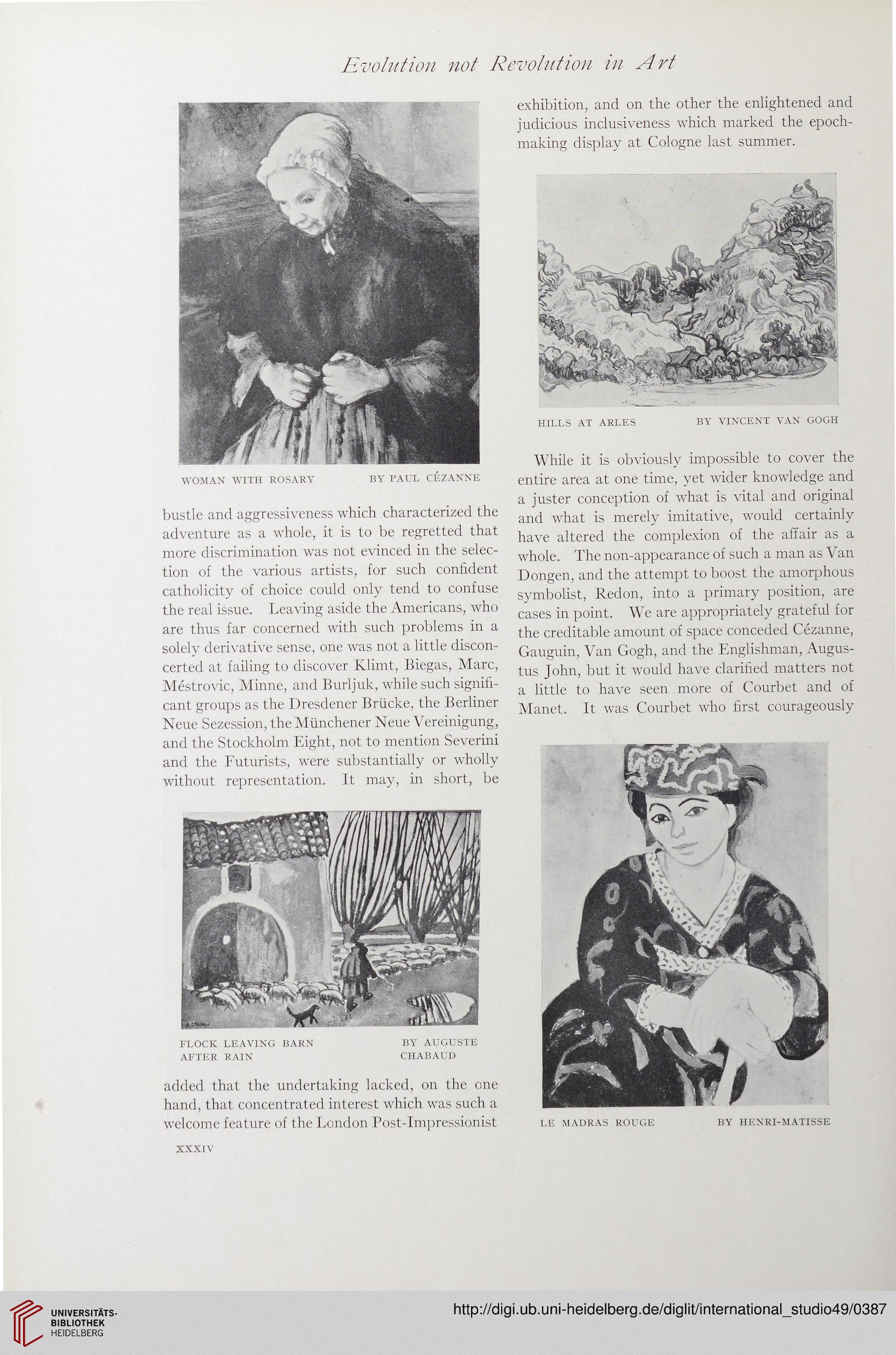Evolution not Revolution in Art
'WGM.KK WITH ROSARY BY PAUL CEZANNE
bustle and aggressiveness which characterized the
adventure as a whole, it is to be regretted that
more discrimination was not evinced in the selec-
tion of the various artists, for such confident
catholicity of choice could only tend to confuse
the real issue. Leaving aside the Americans, who
are thus far concerned with such problems in a
solely derivative sense, one was not a little discon-
certed at failing to discover Klimt, Biegas, Marc,
Mestrovic, Minne, and Burljuk, while such signifi-
cant groups as the Dresdener Briicke, the Berliner
Neue Sezession, the Munchener Neue Vereinigung,
and the Stockholm Eight, not to mention Severini
and the Futurists, were substantially or wholly
without representation. It may, in short, be
FLOCK LEAVING BARN BY AUGUSTE
AFTER RAIN CHABAUD
added that the undertaking lacked, on the one
hand, that concentrated interest which was such a
welcome feature of the London Post-Impressionist
exhibition, and on the other the enlightened and
judicious inclusiveness which marked the epoch-
making display at Cologne last summer.
HILLS AT ARLES
BY VINCENT VAN GOGH
While it is obviously impossible to cover the
entire area at one time, yet wider knowledge and
a juster conception of what is vital and original
and what is merely imitative, would certainly
have altered the complexion of the affair as a
whole. The non-appearance of such a man as Van
Dongen, and the attempt to boost the amorphous
symbolist, Redon, into a primary position, are
cases in point. We are appropriately grateful for
the creditable amount of space conceded Cezanne,
Gauguin, Van Gogh, and the Englishman, Augus-
tus John, but it would have clarified matters not
a little to have seen more of Courbet and of
Manet. It was Courbet who first courageously
LE MADRAS ROUGE
BY HENRI-MATISSE
XXXIV
'WGM.KK WITH ROSARY BY PAUL CEZANNE
bustle and aggressiveness which characterized the
adventure as a whole, it is to be regretted that
more discrimination was not evinced in the selec-
tion of the various artists, for such confident
catholicity of choice could only tend to confuse
the real issue. Leaving aside the Americans, who
are thus far concerned with such problems in a
solely derivative sense, one was not a little discon-
certed at failing to discover Klimt, Biegas, Marc,
Mestrovic, Minne, and Burljuk, while such signifi-
cant groups as the Dresdener Briicke, the Berliner
Neue Sezession, the Munchener Neue Vereinigung,
and the Stockholm Eight, not to mention Severini
and the Futurists, were substantially or wholly
without representation. It may, in short, be
FLOCK LEAVING BARN BY AUGUSTE
AFTER RAIN CHABAUD
added that the undertaking lacked, on the one
hand, that concentrated interest which was such a
welcome feature of the London Post-Impressionist
exhibition, and on the other the enlightened and
judicious inclusiveness which marked the epoch-
making display at Cologne last summer.
HILLS AT ARLES
BY VINCENT VAN GOGH
While it is obviously impossible to cover the
entire area at one time, yet wider knowledge and
a juster conception of what is vital and original
and what is merely imitative, would certainly
have altered the complexion of the affair as a
whole. The non-appearance of such a man as Van
Dongen, and the attempt to boost the amorphous
symbolist, Redon, into a primary position, are
cases in point. We are appropriately grateful for
the creditable amount of space conceded Cezanne,
Gauguin, Van Gogh, and the Englishman, Augus-
tus John, but it would have clarified matters not
a little to have seen more of Courbet and of
Manet. It was Courbet who first courageously
LE MADRAS ROUGE
BY HENRI-MATISSE
XXXIV




